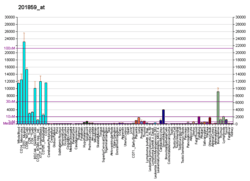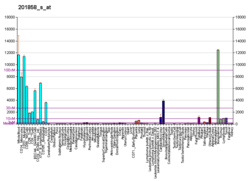Serglycin
Serglycin, also known as hematopoetic proteoglycan core protein or secretory granule proteoglycan core protein, is a protein that in humans is encoded by the SRGN gene.[3] It is primarily expressed in hematopoietic cells and endothelial cells,[4] and is the only known intracellular proteoglycan.[5]
Function
This gene encodes a protein best known as a hematopoietic cell granule proteoglycan. Proteoglycans stored in the secretory granules of many hematopoietic cells also contain a protease-resistant peptide core, which may be important for neutralizing hydrolytic enzymes. This encoded protein was found to be associated with the macromolecular complex of granzymes and perforin, which may serve as a mediator of granule-mediated apoptosis.[3]
References
- GRCh38: Ensembl release 89: ENSG00000122862 - Ensembl, May 2017
- "Human PubMed Reference:". National Center for Biotechnology Information, U.S. National Library of Medicine.
- "Entrez Gene: SRGN serglycin".
- Kolset SO, Tveit H (April 2008). "Serglycin--structure and biology". Cellular and Molecular Life Sciences. 65 (7–8): 1073–85. doi:10.1007/s00018-007-7455-6. PMID 18066495.
- Iozzo RV, Schaefer L (March 2015). "Proteoglycan form and function: A comprehensive nomenclature of proteoglycans". Matrix Biology. 42: 11–55. doi:10.1016/j.matbio.2015.02.003. PMC 4859157. PMID 25701227.
Further reading
- Schick BP (2000). "Regulation of expression of megakaryocyte and platelet proteoglycans". Stem Cells. 14 Suppl 1: 220–31. doi:10.1002/stem.5530140729. PMID 11012225.
- Humphries DE, Nicodemus CF, Schiller V, Stevens RL (July 1992). "The human serglycin gene. Nucleotide sequence and methylation pattern in human promyelocytic leukemia HL-60 cells and T-lymphoblast Molt-4 cells". The Journal of Biological Chemistry. 267 (19): 13558–63. PMID 1377686.
- Nicodemus CF, Avraham S, Austen KF, Purdy S, Jablonski J, Stevens RL (April 1990). "Characterization of the human gene that encodes the peptide core of secretory granule proteoglycans in promyelocytic leukemia HL-60 cells and analysis of the translated product". The Journal of Biological Chemistry. 265 (10): 5889–96. PMID 2180935.
- Mattei MG, Périn JP, Alliel PM, Bonnet F, Maillet P, Passage E, Mattei JF, Jollès P (April 1989). "Localization of human platelet proteoglycan gene to chromosome 10, band q22.1, by in situ hybridization". Human Genetics. 82 (1): 87–8. doi:10.1007/BF00288281. PMID 2714783.
- Avraham S, Stevens RL, Nicodemus CF, Gartner MC, Austen KF, Weis JH (May 1989). "Molecular cloning of a cDNA that encodes the peptide core of a mouse mast cell secretory granule proteoglycan and comparison with the analogous rat and human cDNA". Proceedings of the National Academy of Sciences of the United States of America. 86 (10): 3763–7. doi:10.1073/pnas.86.10.3763. PMC 287220. PMID 2726751.
- Stellrecht CM, Saunders GF (September 1989). "Nucleotide sequence of a cDNA encoding a hemopoietic proteoglycan core protein". Nucleic Acids Research. 17 (18): 7523. doi:10.1093/nar/17.18.7523. PMC 334837. PMID 2798108.
- Stevens RL, Avraham S, Gartner MC, Bruns GA, Austen KF, Weis JH (May 1988). "Isolation and characterization of a cDNA that encodes the peptide core of the secretory granule proteoglycan of human promyelocytic leukemia HL-60 cells". The Journal of Biological Chemistry. 263 (15): 7287–91. PMID 2835370.
- Périn JP, Bonnet F, Maillet P, Jollès P (November 1988). "Characterization and N-terminal sequence of human platelet proteoglycan". The Biochemical Journal. 255 (3): 1007–13. doi:10.1042/bj2551007. PMC 1135341. PMID 3214420.
- Avraham S, Stevens RL, Gartner MC, Austen KF, Lalley PA, Weis JH (May 1988). "Isolation of a cDNA that encodes the peptide core of the secretory granule proteoglycan of rat basophilic leukemia-1 cells and assessment of its homology to the human analogue". The Journal of Biological Chemistry. 263 (15): 7292–6. PMID 3366780.
- Alliel PM, Périn JP, Maillet P, Bonnet F, Rosa JP, Jollès P (August 1988). "Complete amino acid sequence of a human platelet proteoglycan". FEBS Letters. 236 (1): 123–6. doi:10.1016/0014-5793(88)80298-9. PMID 3402609.
- Hatton MN, Loomis RE, Levine MJ, Tabak LA (September 1985). "Masticatory lubrication. The role of carbohydrate in the lubricating property of a salivary glycoprotein-albumin complex". The Biochemical Journal. 230 (3): 817–20. doi:10.1042/bj2300817. PMC 1152688. PMID 4062880.
- Schick BP, Jacoby JA (October 1995). "Serglycin and betaglycan proteoglycans are expressed in the megakaryocytic cell line CHRF 288-11 and normal human megakaryocytes". Journal of Cellular Physiology. 165 (1): 96–106. doi:10.1002/jcp.1041650113. PMID 7559813.
- Kato S, Sekine S, Oh SW, Kim NS, Umezawa Y, Abe N, Yokoyama-Kobayashi M, Aoki T (December 1994). "Construction of a human full-length cDNA bank". Gene. 150 (2): 243–50. doi:10.1016/0378-1119(94)90433-2. PMID 7821789.
- Kolset SO, Mann DM, Uhlin-Hansen L, Winberg JO, Ruoslahti E (April 1996). "Serglycin-binding proteins in activated macrophages and platelets". Journal of Leukocyte Biology. 59 (4): 545–54. doi:10.1002/jlb.59.4.545. PMID 8613703.
- Toyama-Sorimachi N, Kitamura F, Habuchi H, Tobita Y, Kimata K, Miyasaka M (October 1997). "Widespread expression of chondroitin sulfate-type serglycins with CD44 binding ability in hematopoietic cells". The Journal of Biological Chemistry. 272 (42): 26714–9. doi:10.1074/jbc.272.42.26714. PMID 9334256.
- Galvin JP, Spaeny-Dekking LH, Wang B, Seth P, Hack CE, Froelich CJ (May 1999). "Apoptosis induced by granzyme B-glycosaminoglycan complexes: implications for granule-mediated apoptosis in vivo". Journal of Immunology. 162 (9): 5345–50. PMID 10228010.
- Schick BP, Gradowski JF, San Antonio JD (January 2001). "Synthesis, secretion, and subcellular localization of serglycin proteoglycan in human endothelial cells". Blood. 97 (2): 449–58. doi:10.1182/blood.V97.2.449. PMID 11154222.
- Omtvedt LA, Kolset SO, Thoen J, Førre Y, Gill MR (2001). "Serglycin expression in CD2+ and CD14+ cells from patients with various rheumatic diseases". Scandinavian Journal of Rheumatology. 30 (3): 164–6. doi:10.1080/030097401300162941. PMID 11469527.
- Metkar SS, Wang B, Aguilar-Santelises M, Raja SM, Uhlin-Hansen L, Podack E, Trapani JA, Froelich CJ (March 2002). "Cytotoxic cell granule-mediated apoptosis: perforin delivers granzyme B-serglycin complexes into target cells without plasma membrane pore formation". Immunity. 16 (3): 417–28. doi:10.1016/S1074-7613(02)00286-8. PMID 11911826.
This article is issued from Wikipedia. The text is licensed under Creative Commons - Attribution - Sharealike. Additional terms may apply for the media files.



